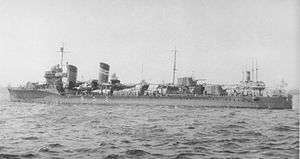Japanese destroyer Miyuki
 Miyuki on 5 September 1931. | |
| History | |
|---|---|
| Name: | Miyuki |
| Ordered: | 1923 Fiscal Year |
| Builder: | Uraga Dock Company |
| Yard number: | Destroyer No. 38 |
| Laid down: | 30 April 1927 |
| Launched: | 26 June 1928 |
| Commissioned: | 29 June 1929 |
| Struck: | 15 August 1934 |
| Fate: | Sunk in collision 29 June 1934 |
| General characteristics | |
| Class and type: | Fubuki-class destroyer |
| Displacement: | |
| Length: |
|
| Beam: | 10.4 m (34 ft 1 in) |
| Draft: | 3.2 m (10 ft 6 in) |
| Propulsion: | |
| Speed: | 38 knots (44 mph; 70 km/h) |
| Range: | 5,000 nmi (9,300 km) at 14 knots (26 km/h) |
| Complement: | 219 |
| Armament: |
|
Miyuki (深雪 ”Deep Snow”)[1] was the fourth of twenty-four Fubuki-class destroyers, built for the Imperial Japanese Navy (IJN) following World War I. When introduced into service, these ships were the most powerful destroyers in the world.[2] They served as first-line destroyers through the 1930s, and remained formidable weapons systems well into the Pacific War.
History
Construction of the advanced Fubuki-class destroyers was authorized as part of the IJN's expansion program from fiscal 1923, intended to give Japan a qualitative edge with the world's most modern ships.[3] The Fubuki class had performance that was a quantum leap over previous destroyer designs, so much so that they were designated Special Type destroyers (特型 Tokugata). The large size, powerful engines, high speed, large radius of action and unprecedented armament gave these destroyers the firepower similar to many light cruisers in other navies.[4] Miyuki, built at the Uraga Dock Company was laid down on 30 April 1927, launched on 29 June 1928 and commissioned on 29 June 1929.[5] Originally assigned hull designation “Destroyer No. 38”, she was completed as Miyuki.
Operational history
On completion, Miyuki, along with her sister ships, Fubuki, Shirayuki, and Hatsuyuki, were assigned to Destroyer Division 11 under the IJN 2nd Fleet. From October to December 1931, she was at Kure Naval Arsenal for repairs to her boilers.[6]
Miyuki was lost in a collision with the Japanese destroyer Inazuma on 29 June 1934 in the Korea Strait, south of Cheju. (33°00′N 125°30′E / 33.000°N 125.500°ECoordinates: 33°00′N 125°30′E / 33.000°N 125.500°E) The number of casualties is not certain, but at least five crewmen perished in the accident. Miyuki was struck from the navy list on 15 August 1934.[7]
Miyuki was the only modern Japanese destroyer that did not make it into World War II, and was the only instance a Japanese destroyer was lost in a collision against other Japanese destroyers.
Notes
- ↑ Nelson. Japanese-English Character Dictionary. Page 558
- ↑ Globalsecurity.org. "IJN Fubuki class destroyers".
- ↑ Fitzsimons, Illustrated Encyclopedia of 20th Century Weapons and Warfare p.1040
- ↑ Peattie & Evans, Kaigun page 221-222.
- ↑ Nishidah, Hiroshi (2002). "Fubuki class 1st class destroyers". Materials of the Imperial Japanese Navy.
- ↑ Nevitt, Allyn D. (1997). "IJN Miyuki: Tabular Record of Movement". Long Lancers. Combinedfleet.com.
- ↑ Nishidah, Hiroshi (2002). "Fubuki class destroyers". Materials of the Imperial Japanese Navy.
References
- Howarth, Stephen (1983). The Fighting Ships of the Rising Sun: The Drama of the Imperial Japanese Navy, 1895–1945. Atheneum. ISBN 0-689-11402-8.
- Jentsura, Hansgeorg (1976). Warships of the Imperial Japanese Navy, 1869–1945. US Naval Institute Press. ISBN 0-87021-893-X.
- Nelson, Andrew N. (1967). Japanese–English Character Dictionary. Tuttle. ISBN 0-8048-0408-7.
- Whitley, M J (2000). Destroyers of World War Two: An International Encyclopedia. London: Arms and Armour Press. ISBN 1-85409-521-8.
External links
- Nishidah, Hiroshi (2002). "Fubuki class destroyers". Materials of the Imperial Japanese Navy.
- Globalsecurity.org. "IJN Fubuki class destroyers".